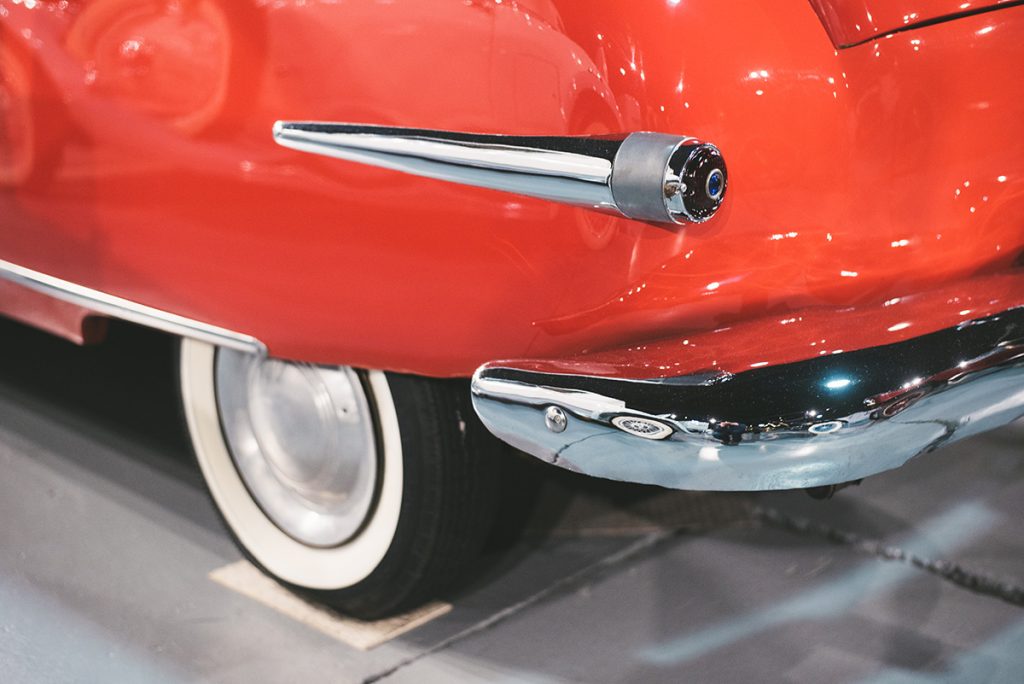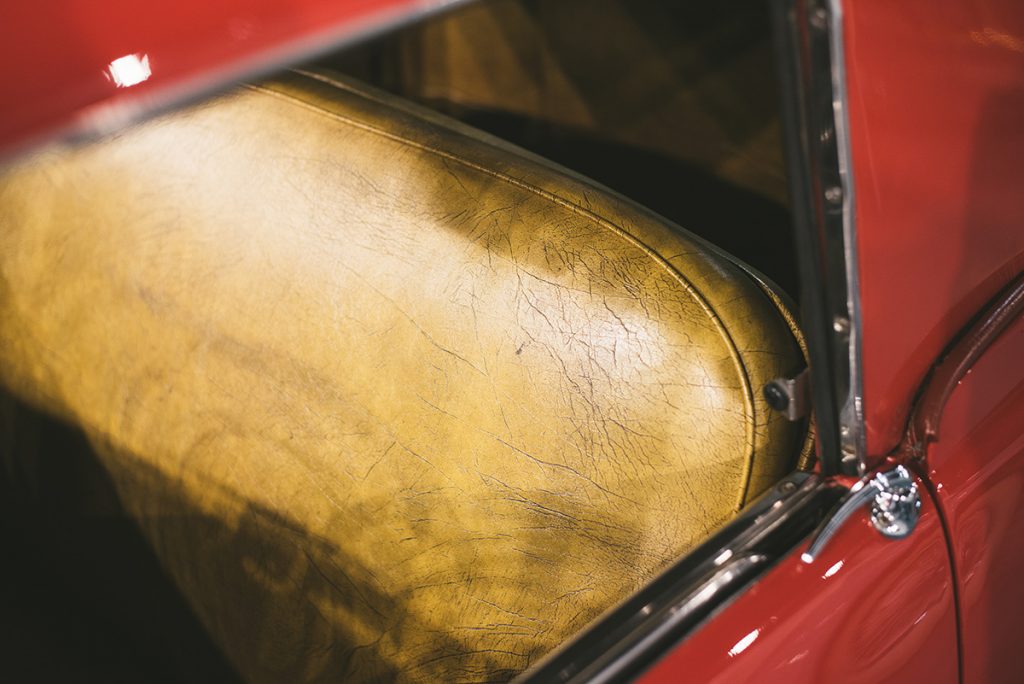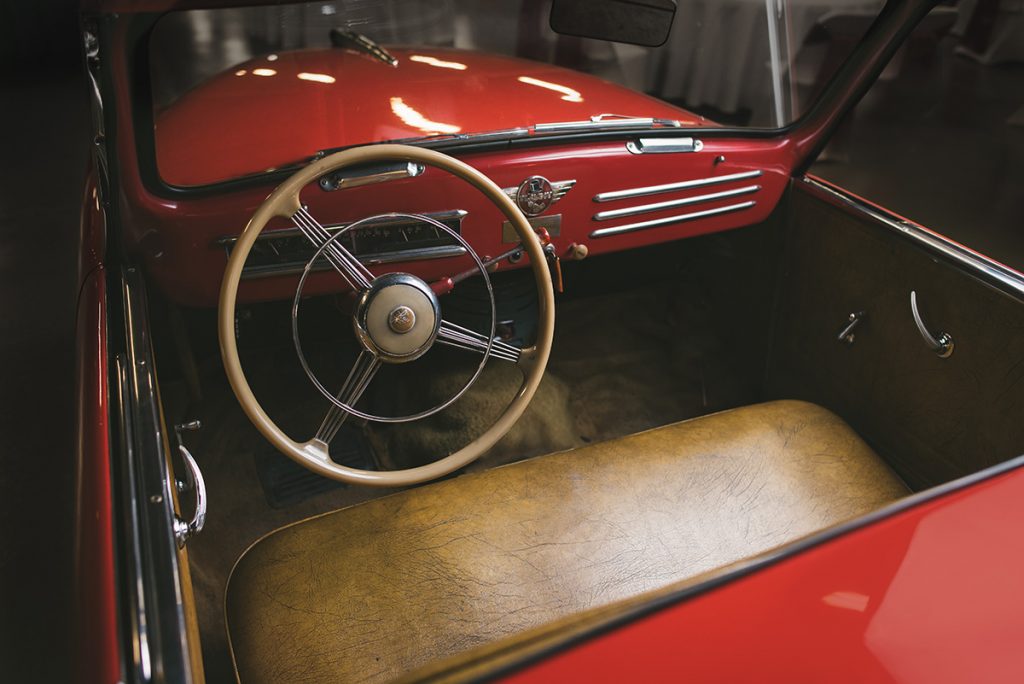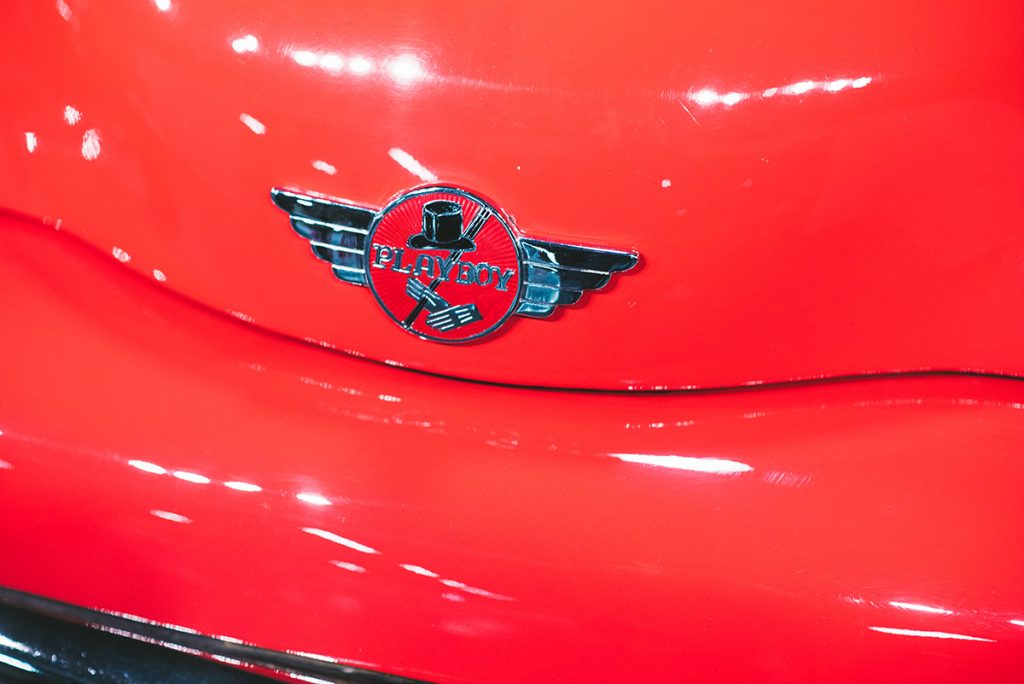Everyone is familiar with the legendary men’s magazine Playboy, but many may not be familiar with the car of the same name. The Playboy car was built in the late forties in Buffalo, New York. Is there an association with the Playboy magazine and the Playboy car? The answer is yes!
Actually, the Playboy car came first and the story goes like this: A woman who worked for the Playboy car company, in the Chicago sales office, had a son who was friends with Hugh Hefner, the founder of Playboy magazine. After the demise of the Playboy car, it was the woman’s son, Eldon Sellers, who suggested Playboy as the name for the magazine and Hugh Hefner liked it enough to use it. The rest is history.
The Playboy Motor Car Corporation was one of many car manufacturers that were located in Buffalo, New York in the first half of the twentieth century. Those included the Pierce-Arrow Motor Car Company, which at its height was acknowledged to be the country’s finest automobile, and the Thomas Motor Company, that built the car known as the Thomas Flyer which won the 1908 automobile race around-the-world, covering some 22,000 miles.
To learn more about the Playboy car, I recently had the pleasure of talking with David Kaplan, the founder’s grandson and owner of several playboy cars, and Ed Howard, the Playboy car webmaster and the owner of car #34. Thanks to the efforts of both men the intriguing legacy and history of this very interesting car has been preserved. David, who lives in western New York, was only two years old when his grandfather passed away. He has acquired an intimate knowledge of his grandfather, Lou Horwitz, through extensive research and preservation of several Playboy cars, documents, artifacts and photos from the company.
Lou Horwitz was a hardworking man with a strong entrepreneurial spirit. During the 1930s he worked several different jobs, including a job at a Packard dealership as a sales manager. Lou had also owned a used car lot. When repairs were needed, he sent the cars to Norm Richardson, a talented mechanic, who owned a collision shop in Buffalo. While visiting at the shop, Horwitz learned that Richardson and a former Pontiac engineer by the name of Charlie Thomas, were working on building a car. When completed in 1938, the Thomas Rocket Car had several innovative design features that Charlie Thomas had dreamed up from a college thesis paper he had written.
 After WWII, Horwitz pursued the idea of starting a car company in an effort to meet the pent up demand for automobiles. In 1946, the three men joined forces and formed The Playboy Motor Car Corporation, with Horwitz as president, Thomas as vice-president, and Richardson as treasurer. The intent was to create a small car, priced at less than $1,000 for “around-the-town errands”. To get the company off the ground, Horwitz put up $50,000 of his own money to build the first prototype car. The car was designed by Thomas and it took about seven months for the three men to build it in secret at Richardson’s shop. Upon completion, the car was displayed at the Hotel Statler in Buffalo for a week in February of 1947. The interest and demand for the car was high. The car had a rear mounted 4-cylinder engine, a soft-top convertible and was considered a three passenger car. Horwitz’s grandson, David, was able to find and purchase that original prototype car many years ago. It was restored and is currently on display at the Saratoga Automobile Museum in Saratoga Springs, NY.
After WWII, Horwitz pursued the idea of starting a car company in an effort to meet the pent up demand for automobiles. In 1946, the three men joined forces and formed The Playboy Motor Car Corporation, with Horwitz as president, Thomas as vice-president, and Richardson as treasurer. The intent was to create a small car, priced at less than $1,000 for “around-the-town errands”. To get the company off the ground, Horwitz put up $50,000 of his own money to build the first prototype car. The car was designed by Thomas and it took about seven months for the three men to build it in secret at Richardson’s shop. Upon completion, the car was displayed at the Hotel Statler in Buffalo for a week in February of 1947. The interest and demand for the car was high. The car had a rear mounted 4-cylinder engine, a soft-top convertible and was considered a three passenger car. Horwitz’s grandson, David, was able to find and purchase that original prototype car many years ago. It was restored and is currently on display at the Saratoga Automobile Museum in Saratoga Springs, NY.
In May of 1947, a few months after the showing at the Hotel Statler, the founders started a “pre-production” run and hand-built 95 cars. There were improvements made in the design, like moving to a front engine configuration and thereby avoiding some of the difficulties associated with the engineering and servicing of a rear engine car. Also, using the idea that Richardson had of making the car as easy to produce as possible, the company purchased parts from various manufacturers, while the body and trim pieces were made at a shop on Ellicott Street in Buffalo. As Ed Howard explained, the cars built were sometimes referred to as “garage built” or “assembled cars”, as most of the parts were from other manufacturers because they were readily available. The parts came from Studebaker, Chevy and many other manufacturers. The transmission was a Borg-Warner, 3-speed on the tree, plus an overdrive gear. The engines that were used also had to be readily available and as such, they used Continental, Hercules and they even tried a Willys engine in a car. These engines were typically used in fork trucks, tractors, and stationary applications. Ed said that the Hercules engine, which is the engine in his car, has 40 hp, however some of the engines were modified and had 48 hp. One of the most unique features on the car was the all-steel disappearing hard-top. At the time, that was considered a one-of-a-kind feature for car design.
 The pre-production run of cars was intended to create publicity for building a network of 800-900 dealers throughout the country. The dealer locations were selected based on the population in a particular area. The cars were then displayed at the various dealers throughout the network to generate publicity, prior to the planned full-scale production. The goal was to manufacture 100,000 cars per year, certainly an ambitious goal. To get a factory up and running required an investment of $20 million, and the financing would come from two sources, the purchasing of franchises by the dealer network and the sale of stock.
The pre-production run of cars was intended to create publicity for building a network of 800-900 dealers throughout the country. The dealer locations were selected based on the population in a particular area. The cars were then displayed at the various dealers throughout the network to generate publicity, prior to the planned full-scale production. The goal was to manufacture 100,000 cars per year, certainly an ambitious goal. To get a factory up and running required an investment of $20 million, and the financing would come from two sources, the purchasing of franchises by the dealer network and the sale of stock.
Next, in January of 1948, they purchased a much larger, up-to-date plant just outside the city of Buffalo. The planning and tooling was started in anticipation of full-scale production of the cars. Everything was coming together to manufacture and sell the Playboy car.
Unfortunately for the Playboy Motor Car Corp, an unrelated event changed the future and the untimely demise of the Playboy car. The Tucker Corp from Chicago, much like the Playboy Motor Car Corp, was a startup car company in the late 1940s. They had a program, prior to their full-scale production, in which they were selling car accessories as a means of raising additional capital. Those that purchased accessories were put on the waiting list to purchase a car. This program, along with some other practices, got the attention of the Securities and Exchange Commission who began an investigation. The investigation led to indictments and a subsequent trial by the SEC. The trial generated a lot of negative publicity, which scared off many investors. After all the negative publicity, The Tucker Corp filed for bankruptcy in March of 1949. It’s interesting that in the end the Tucker car company was cleared of any wrongdoing however, the damage was already done.
The stock sale for the Playboy Company was in May of 1948, just a few months after the demise of The Tucker Corp…the timing couldn’t have been worse. It was sufficient enough to scare off many investors from purchasing all of the stock that was needed to proceed with full-scale production.
 A second stock sale was attempted in March of 1949, for much less capital due to the scaled back production goal, but that failed as well. As David Kaplan explained, investors got “cold feet” and would not make the investments needed for the Playboy car production to continue. On April 14, 1949, the Playboy Motorcar Company filed for bankruptcy. David went on to say that in the end, his grandfather, who worked incredibly hard, lost everything, including his house and all his money.
A second stock sale was attempted in March of 1949, for much less capital due to the scaled back production goal, but that failed as well. As David Kaplan explained, investors got “cold feet” and would not make the investments needed for the Playboy car production to continue. On April 14, 1949, the Playboy Motorcar Company filed for bankruptcy. David went on to say that in the end, his grandfather, who worked incredibly hard, lost everything, including his house and all his money.
In all, the Playboy Motor Car Corporation built 99 cars, which included: the prototype, 95 “pre-production” cars and 3 “production” cars.
The following official count is provided by David Kaplan:
Prototype car, rear mounted engine, currently on display at the Saratoga Automobile Museum
Cars # 1 to 95 are the pre-production cars, including one station wagon (#95)
Note: next 5 serial numbers were skipped
Car #100 is the first production car
Car #101 is the first production station wagon
Car# 102 is the last production car and at that time and was not finished. It is currently owned by David Kaplan and has been recently restored.
So what happened to the cars after the company went bankrupt, since none were sold to the public? After bankruptcy, most of the cars that were in possession of the dealer franchises were just kept by them. Some that were remaining, after the bankruptcy, were sold off to Donald Moore, a former Playboy dealer from Massachusetts, who wound up losing money, but really loved the car.
 David Kaplan, in the late 1980’s, managed to purchase five of the ten cars that Donald Moore owned. David felt that Moore sold him the cars because of his interest and the fact that he was the grandson of the founder. In the subsequent years, he maintained his friendship with Moore until his passing. In addition to the first prototype car, he owns car #7 (a parts car), #68, #83, #92 and the last car #102. Also, car #83 is on display at the Northeast Classic Car Museum.
David Kaplan, in the late 1980’s, managed to purchase five of the ten cars that Donald Moore owned. David felt that Moore sold him the cars because of his interest and the fact that he was the grandson of the founder. In the subsequent years, he maintained his friendship with Moore until his passing. In addition to the first prototype car, he owns car #7 (a parts car), #68, #83, #92 and the last car #102. Also, car #83 is on display at the Northeast Classic Car Museum.
For information about the intriguing history of the Playboy car, check out the following website that is maintained by Ed Howard (www.playboymotorcars.com). It is loaded with additional in-depth information about the car, including many photos. If interested in more information about the Tucker car, there is an entertaining movie titled, Tucker: The Man and His Dream.
Story: Bob Sblendorio
Photos: Thomas Sblendorio


Just when I thought I knew everything about post WWII car brands that failed, something like the Playboy car comes along that I’ve never even heard of before.